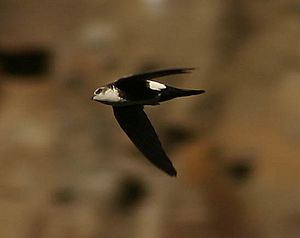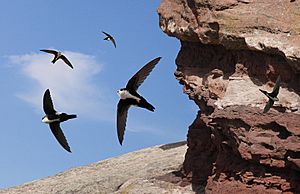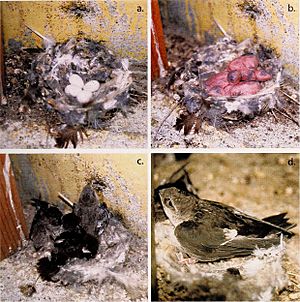White-throated swift facts for kids
Quick facts for kids White-throated swift |
|
|---|---|
 |
|
| Spokane County, Washington | |
| Conservation status | |
| Scientific classification | |
| Genus: |
Aeronautes
|
| Species: |
saxatalis
|
| Subspecies | |
|
Aeronautes saxatalis nigrior |
|
 |
|
The white-throated swift (Aeronautes saxatalis) is a type of swift bird. It belongs to the Apodidae family. These birds live in western North America, reaching as far south as the mountain areas of western Honduras. Along the coast, they live as far north as Northern California. Inland, they migrate through the Great Basin and Rocky Mountain regions, going north to southern British Columbia.
White-throated swifts like open areas near cliffs, rocky places, or human-made buildings. This is where they rest. Swifts are social birds. You often see groups of them resting and hunting for flying insects together.
Contents
What Does a White-throated Swift Look Like?
The White-throated swift is a medium-sized bird. It is mostly black and white. Its back and wings are dark brown or black. Its chest, belly, chin, and throat are white. When adults have new feathers, the dark ones might have a slight green shine. However, this is hard to see when you are watching them in nature.
Males and females look the same. Young swifts look a lot like adult swifts. But the feathers on the heads and necks of young birds are usually duller and paler.
Adult swifts are usually 15–18 centimeters (about 6-7 inches) long. Their tail has a small notch about 10 millimeters deep. Adult swifts weigh between 28 and 36 grams (about 1-1.3 ounces). The average weight is 32.5 grams. There is no size difference between males and females. The White-throated swift has a wingspan of 35.5 centimeters (about 14 inches).
White-throated swifts can look similar to Black Swifts and Vaux's Swifts. These other swift species also live in western North America. But you can tell White-throated swifts apart because they have white underparts. The other two species do not have white underparts.
White-throated Swift Family Tree
Scientists debate where White-throated swifts fit in the bird family tree. Some groups place them in the order Caprimulgiformes. Others put them in Apodiformes. It's hard to place them because swifts look very similar. This makes it difficult to figure out their evolutionary history.
At lower levels of the family tree, White-throated swifts belong to the Apodidae family. They are in the genus Aeronautes. This genus includes only two other species: the Andean swift (Aeronautes andecolus) and the White-tipped swift (Aeronautes montivagus).
There are two types of White-throated Swift, called subspecies: A. s. saxatalis and A. s. nigrior.
- A. s. saxatalis birds spend winter in North America, south to the Isthmus of Tehantepec in Oaxaca, Mexico.
- A. s. nigrior birds spend winter south of Oaxaca, down to Honduras.
A. s. saxatalis birds often have a clearer white stripe above their eye. They also have darker upper parts and a wider white stripe on their belly than A. s. nigrior birds.
Where White-throated Swifts Live
Swift Distribution Across North America
White-throated swifts live all year in coastal and southern California, southern Arizona, southern New Mexico, western Texas, central Mexico, and the Sierra Madre Occidental and Oriental mountains.
Populations that migrate to breed can be found from Arizona and New Mexico north to southern British Columbia. They also live from central California east to eastern Colorado and Wyoming. In the southern part of their migration range, birds arrive in mid-March and leave in mid-October. In the northern part, they arrive in mid-April to early-May and leave in late-August to mid-September.
There are two main areas where swifts spend the winter (non-breeding season):
- The first area includes southwestern California, eastern Arizona, and the Texas Panhandle.
- The second area is in El Salvador, Guatemala, Honduras, and the Mexican state of Chiapas.
Swift Habitat and Homes
Swifts rest in cliffs, bluffs, and canyons. They also use human-made structures like bridges, overpasses, and quarry walls. In nature, swifts form groups of up to 400–500 birds. They rest in protected cracks in cliffs, usually 6–50 meters (about 20-164 feet) above the ground.
White-throated swifts sometimes rest and build nests near colonies of other swallow species. These include Cliff, Violet-Green, and Northern Rough-Winged Swallows. When hunting for food, White-throated swifts fly over meadows, farm fields, and open areas along the edges of hills.
White-throated Swift Behavior
White-throated swifts are very fast flyers. They rarely land, except to rest. Swifts usually fly 10–100 meters (about 33-330 feet) above the ground. They use wind currents and updrafts (rising air) to fly faster. White-throated swifts usually leave their resting spots in the morning. They fly and hunt all day until late afternoon or evening.
While flying, swifts are sometimes seen bathing. They hit the surface of the water with their belly. After that, they clean their feathers while still in the air. Sometimes, White-throated swifts will fight with each other while flying. They might chase or hit other White-throated swifts or Violet-Green Swallows.
What White-throated Swifts Eat and Who Eats Them
Swifts eat insects they catch in the air. They often hunt in areas where air is rising, like along the edges of canyons, foothills, or mountains. White-throated swifts have also been seen hunting over farm fields. They sometimes follow farm machines to catch insects that are disturbed by the equipment.
Scientists have studied what's in their stomachs. They found that beetles, flies, bees, and true bugs (Hemiptera) make up most of a White-throated swift's diet. Adult swifts feed their babies by carrying a ball of insects in their mouth area. They then feed it to the young birds. Swifts get most of their water from their food. But they can also drink by skimming the surface of ponds.
Birds that hunt White-throated swifts include Peregrine falcons, Prairie falcons, and American kestrels. When swifts see predators, they quickly fly lower. They fly just above the plants to escape. There isn't much information about predators eating swift nests.
White-throated Swift Sounds
White-throated swifts make sounds while flying. These sounds are described as "staccato chattering" (short, sharp sounds). They might also make a sharp one- or two-note call. Or they might make a loud, long "scree" call. In the morning and evening, they might make "twittering" sounds at their resting spots. Young swifts might make begging sounds. These are higher-pitched versions of the adult's "scree" call.
White-throated Swift Reproduction and Life Cycle
During the time they look for mates, White-throated swifts might do special gliding flights. They also perform fast, plummeting falls to attract a partner. After a pair forms, they are usually monogamous (stay with one partner).
They build nests from plant material and feathers. They use their saliva to hold the nest together. Nests are built on rocky cliff faces or human-made structures. These nests are usually 8–10 centimeters (about 3-4 inches) wide and 2.5–2.8 centimeters (about 1 inch) deep. They may use the same nest for several years.
An average of 4–5 white, dull eggs are laid over 4–6 days. The parents usually start sitting on the eggs only after the last egg is laid. In the southern parts of their range, eggs are laid in April. But in more northern areas, eggs are usually laid throughout May. The average date for the first egg is May 13.
The eggs hatch after about 24 days. When swifts hatch, they weigh about 2 grams. Both parents feed the baby birds. By the time they are ready to fly, swifts can weigh up to 46 grams. There are no known cases of swifts trying to have a second group of babies if the first nest fails.
White-throated Swift Conservation Status
Across North America, the number of White-throated swifts has gone down by 2.8% from 1966–1998. This is considered a significant drop. These declines might be due to losing places to rest and nest. This happens because of quarrying (taking stone from the ground), mining, and tearing down old buildings. Also, there might be less food because of pesticide use.
However, in some areas, swift populations seem to be growing. Most populations appear stable. It's hard to understand all this information because these birds are spread out in different places. But the overall decline is a concern, especially since other birds that eat insects in the air are also declining.
Images for kids
See also
 In Spanish: Vencejo gorgiblanco para niños
In Spanish: Vencejo gorgiblanco para niños





